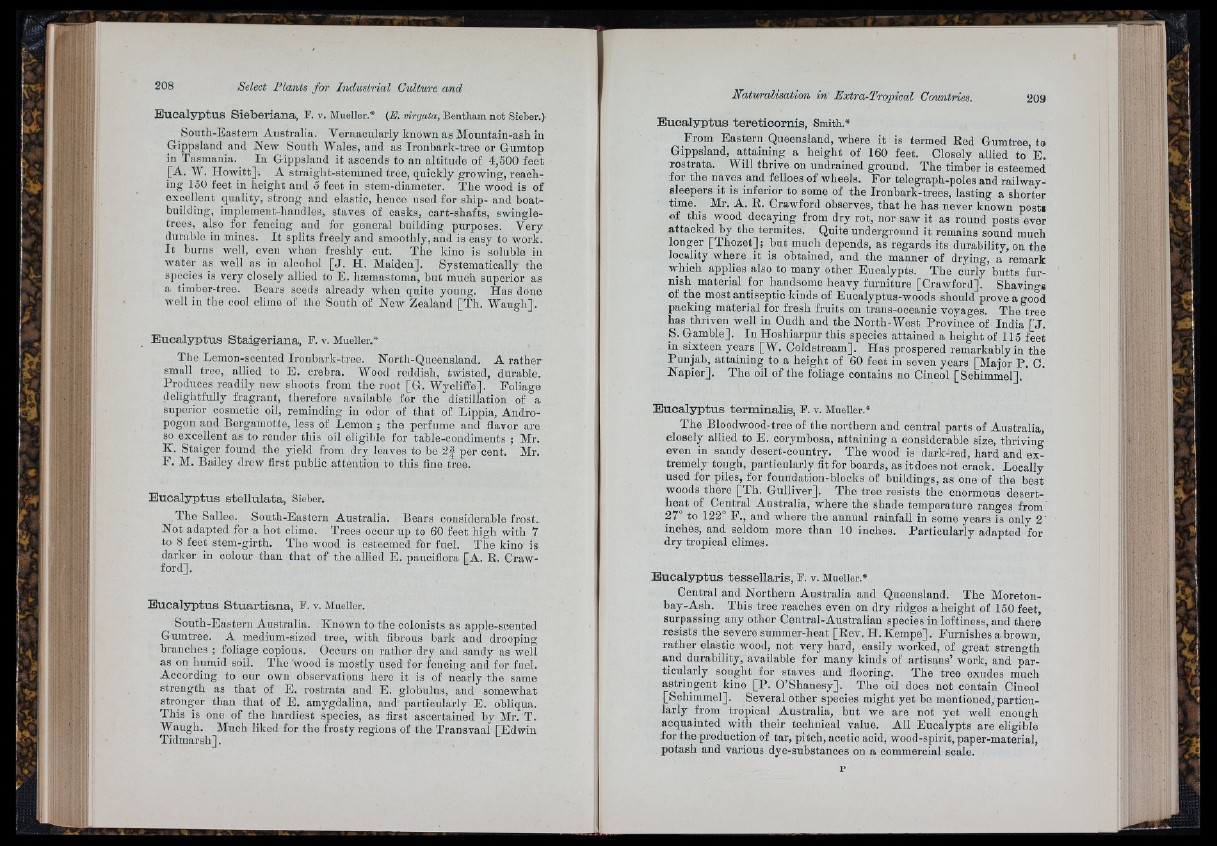
Eucalyptus Sieberiana, F. v. Mueller.* [E. virgata, Bentham not Sieber.)
South-Eastern Australia. Vernacularly known as Mountain-ash in
Gippsland and New South Wales, and as Ironbark-tree or Gumtop
in Tasmania. In Gippsland it ascends to an altitude of 4,500 feet
[A. W. Howitt]. A straight-stemmed tree, quickly growing, reaching
loO feet in height and 5 feet in stem-diameter. The wood is of
excellent quality, strong and elastic, hence used for ship- and boatbuilding,
implemeiit-handles, staves of casks, cart-shafts, swingle-
trees, also for fencing aud for general building purposes. Very
durable in mines. I t splits freely and smoothly, and is easy to work.
I t burns well, even when freshly cut. The kino is soluble in
water as well as iu alcohol [ J . H. Maiden]. Systematically the
species is very closely allied to E. hsemastoma, but much superior as
a timber-tree. Bears seeds already when quite young. Has done
well in the cool clime of the Sonth'of New Zealand [T h . Waugh].
Eucalyptus Staigeriana, F. v. Mueller.*
The Lemon-scented Ironbark-tree. North-Queensland. A rather
small tree, allied to E . crebra. Wood reddish, twisted, durable.
Produces readily new shoots from the root [G. Wyoliffe]. Foliage
delightfully fragrant, therefore available for the distillation of a
superior cosmetic oil, reminding iu odor of th a t of Lippia, Andropogon
and Bergamotte, less of Lemon ; the perfume and flavor are
so excellent as to render this oil eligible for table-condiments ; Mr.
K. Staiger found the yield from dry leaves to bo 2 f per cent. Mr.
F . M. Bailey drew first public attention to this fine tree.
E u c a ly p tu s s te llu la ta , Sieber.
The Sallee. South-Eastern Australia. Bears considerable frost.
Not adapted for a hot clime. Trees occur up to 60 feet high with 7
to 8 feet stem-girth. The wood is esteemed for fuel. The kino is
darker in colour than that of the allied E. pauciflora [A. R. Crawford]
.
Eucalyptus Stuartiana, F. v. Mueller.
South-Eastern Australia. . Known to the colonists as apple-scented
Gumtree. A medium-sized tree, with fibrous bark and drooping
branches ; foliage copious. Occurs on rather dry and sandy as well
as on humid soil. The wood is mostly used for fencing and for fuel.
According to our own observations here it is of nearly the same
strength as th a t of E. rostrata and E. globnlns, and somewhat
stronger than that of E. amygdalina, and particularly E. obliqua.
This is one of the hardiest species, as first ascertained by Mr. T.
'W augh. Much liked for the frosty regions of the Transvaal [Edwin
Tidmarsh].
Eucalyptus tereticornis. Smith.*
From Eastern Queensland, where it is termed Red Gumtree, to
Gippsland, attaining a height of 160 feet. Closely allied to E .
rostrata. Will thrive on undrained ground. The timber is esteemed
for the naves and felloes of wheels. For telegraph-poles and railway-
sleepers it is inferior to some of the Ironbark-trees, lasting a shorter
time. ^ Mr. A. R. Crawford observes, th a t he has never known posti
of this wood decaying from dry rot, nor saw it as round posts ever
attacked by the termites. Quite underground it remains sound much
longer [T h o z e t]; but much depends, as regards its durability, on the
locality where it is obtained, and the manner of drying, a remark
which applies also to many other Eucalypts. The curly butts furnish
material for handsome heavy furniture [Crawford]. Shavings
of the most antiseptic kinds of Euealyptus-woods should prove a good
packing material for fresh fruits on trans-oceanic voyages. The tree
has thriven well in Oudh and the North-West Province of India [ J .
_S. Gamble]. In Hoshiarpur this species attained a height of 115 feet
in sixteen years [W. Coldstream]. Has prospered remarkably in the
Punjab, attaining to a height of 60 feet in seven years [Major P . C.
Napier]. The oil of the foliage contains no Cineol [Schimmel].
Eucalyptus terminalis, F. v. Mueller.*
The Bloodwood-tree of the northern and central parts of Australia,
closely allied to E. corymbosa, attaining a considerable size, thriving
even in sandy desert-country. The wood is dark-red, hard and extremely
tough, particularly fit for boards, as it does not crack. Locally
used for piles, for foundation-blocks of buildings, as one of the best
woods there [T h . Gulliver]. The tree resists the enormous desert-
heat of Central Australia, where the shade temperature ranges from'
27° to 122° F., and where the annual rainfall in some years is only 2 '
inches, and seldom more than 10 inches. Particularly adapted for
dry tropical climes.
Eucalyptus tessellaris, F. v. Mueller.*
Central and Northern Australia and Queensland. The Moreton-
bay-Ash. This tree reaches even on dry ridges a height of 150 feet,
surpassing any other Central-Australian species in loftiness, and there
resists the severe summer-heat [Rev. H. Kempe]. Furnishes a brown,
ra th e r elastic wood, not very hard, easily worked, of great strength
and durability, available for many kinds of artisans’ work, and particularly
sought for staves and flooring. The tree exudes much
astringent kino [P . O’Shanesy]. The oil does not contain Cineol
[Schimmel]. Several other species might yet be mentioned, particularly
from tropical Australia, but we are not yet well enough
acquainted with their technical value. All Eucalypts are eligible
for the production of tar, pitch, acetic acid, wood-spirit, paper-material,
potash and various dye-substances on a commercial scale.